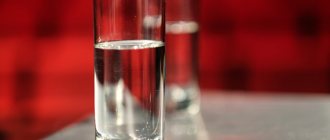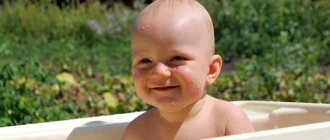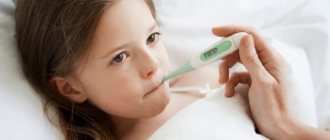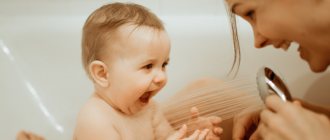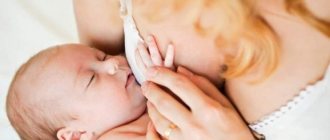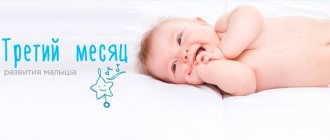A baby is born with innate adaptation to environmental conditions. This is a kind of defense mechanism, a reaction to getting from the mother’s womb into unusual conditions. Hardening of newborns is an effective way to support and strengthen the health of a child. It supports the baby’s strength given to him by nature. They increase the body's protective functions, improve thermoregulation and metabolic processes, improve blood circulation, promote harmonious physical and mental development, increase appetite and quality of sleep.
The process is based on regular and smooth changes in the influence of the surrounding space. Use the time of changing clothes, walking, bathing or sleeping. Hardening children under one year old is especially effective if additional gymnastics is performed or massage is performed.
The results are obvious if the baby is not placed in special conditions of sterility, lack of fresh air, or excessive wrapping.
Age recommendations
It is recommended to start 6-7 days after the birth of the child, since the newborn’s body is able to easily adapt. If you didn’t catch this moment, it’s okay. You can start training at any age.
It is better to choose a warm season, especially for infants, taking into account the emotional and physical health of the baby at this moment. Please consult your pediatrician first.
Below are recommendations that are appropriate for an infant up to one year of age.
0-3 months
- The air in the room is 22 °C
- Sleeping outside is permissible from – 15°С to + 30°С
- Swaddling and massage – air baths 5 min
- Washing with water 28°C
- Taking a bath 36-37°C 5 min
3-6 months
- The air in the room is 20-22°C
- Sleeping outside is permissible from – 15°С to + 30°С
- Swaddling and massage – air baths 8 min
- Washing with water 25-26°C
- Taking a bath 36-37 °C 5 min. After this, pouring water at 34-35 ° C is added
- It is permissible to be in sunlight for 5 minutes 3 times a day.
6-12 months
- The air in the room is 20-22°C
- Sleeping outside is permissible from – 15°С to + 30°С
- Period of wakefulness, swaddling and massage - air baths 10 min.
- Washing with water 20-24°C
- Taking a bath 36-37 °C 5 min. After this, pouring cool water at 34-35 ° C is added
- Dry rubbing for 1 week using a flannel mitten until slight redness of the skin appears. After – wet rubbing with gradual cooling from 35 °C to 30 °C
- It is permissible to be in sunlight for 10 minutes 3 times a day.
Positive Impact
Do not forget that hardening exposes the entire small organism to stress, both physically and psychologically. How then can you make such a procedure useful if your child is squirming and crying? Start small, if you have chosen water hardening, and your child is afraid to plunge into a cold bath - start by rubbing the legs and arms with a cold cloth, and all this gradually. Next, you can pour cold water into a small basin and stomp it there with your feet. And in such small steps, move on, having achieved procedures in the bath.
If your baby is too active and frisky, then evening hardening will not benefit him, but will only harm his healthy sleep; such improvement can be postponed to any other time. And if your little one likes to sleep and is reluctant to wake up, morning procedures will only be beneficial, which will help you wake up and activate the body. But remember, you always need to be very patient, it is natural that children do not like such stimuli, you will not be able to explain to them the benefits of such activities, so you must do everything possible to ensure that your child receives positive emotions from this.
To harden an infant or not
Hardening rules
Hardening of a newborn or infant should be carried out gradually and carefully. You should start at a time when the baby is healthy. Make sure it does not have the following contraindications:
- sleep disorders
- excitability
- digestive problems
- ARVI
- heart problems
- decreased hemoglobin level
- elevated body temperature
To achieve high success in hardening young children, you should adhere to the following recommendations:
- adherence to routine and routine
- balanced diet
- physical exercises (dynamic gymnastics and massage)
The baby must be emotionally ready, and the parents must be calm and in a good mood. This attitude will definitely be passed on to the child. You can use play forms during the process to distract your baby.
It is better to first learn about the principles of gentle hardening. Remember the sequence, because the desired result can only be achieved by a smooth change in the ambient temperature and exposure time. Regularity is also important - every day all year without breaks for more than 5 days.
If the baby reacts negatively, cries, or shows dissatisfaction, you should check if you are doing everything right. If everything is correct, postpone it until a later date.
From the first days you should start with washing, taking baths, adjusting the climate in the room and walking, regardless of the time of year. In summer, swimming, walking and air baths are effective. In winter, it is allowed to replace them by ventilating the room, as well as washing and dousing the feet.
To harden an infant or not: results
The use of cold water was considered the most effective way to “produce heat and increase vitality.” Children who were treated with cold water were rarely exposed to colds, seizures and other childhood diseases such as measles, scarlet fever, and diphtheria.
Of course, it is much easier to “stuff” your child with medications and take him to doctors than to devote so much time to hardening your baby, precisely to prevent such frequent trips to the doctor and taking medications.
Air hardening of a baby
Types of healing are based on the influence of natural factors in combination with physical exercise. Let's take a closer look.
Walks
You can start from birth, even in winter, if there is no strong wind. Dress your child appropriately for the weather and time of year, and avoid overheating due to the large number of layers of clothing. The first walk can last up to a quarter of an hour. Gradually, the time spent outdoors is increased to 1-2 hours. In summer it is permissible to walk longer.
Sleeping on the street
You can combine a walk with sleep. If it is calm and deep, the baby quickly falls asleep and wakes up in a good mood, then we can talk about a correctly constructed scheme. Anxiety, sweaty skin or, conversely, a cold nose and hands indicate overheating or hypothermia.
Air baths
When changing a diaper, changing clothes or feeding a child, it is necessary to leave him undressed for 3-5 minutes. By six months, gradually increase to 8-10 minutes a couple of times a day. By the age of one year, the time can be extended to a quarter of an hour 2-3 times a day. The skin should have a pinkish tint and be warm to the touch. Can be accompanied by physical exercise. In summer, outdoor baths in the shade are allowed.
From one to three years
At this age, children are quite resistant to many unfavorable factors, especially if hardening has been carried out since birth. Therefore, more contrasting methods can be used. You can carry out general rubdowns with a decrease in water temperature to 26-28 C, use a shower, which has a stronger effect, since in addition to the temperature factor, there is also a mechanical effect of the water flow on the child’s skin, which has a massaging effect.
From one and a half to two years old, a child can be allowed to swim in open reservoirs at a water temperature of +21 C and an air temperature of +25 C or more. The first bath is 1-2 minutes, then a break of 10-15 minutes. It is very important not to scare the child - do not drag him into the water, let him go in on his own.
Children over 1 year of age can gradually undergo sunbathing. The air temperature should be from +20 C to +30 C (but no more!), start spending time in the sun gradually from 5-10 minutes to 30-40 minutes.
The best time for sunbathing is in the morning from 9 to 12 o'clock; in hot weather you can sunbathe from 16 to 18 o'clock. Don’t forget to put a Panama hat on your child’s head. Carefully monitor your child's skin - if there is the slightest redness, exposure to the sun should be stopped for 1-2 days.
It is not advisable for children under three years of age to undergo contrasting hardening procedures (cold shower, sauna, Russian bath), since the child is not yet able to assess his well-being, and subsequently it will be difficult to determine the line between the beneficial effects of this method and the negative ones.
Water treatments
Water hardening can begin from birth. It is divided into traditional and non-traditional (intensive). Traditional methods require a gradual decrease in temperature when washing, washing and bathing. Later you can try intensive options - rubbing and dousing.
Washing and rinsing
For a newborn baby, 28°C is recommended, later reduced to 21°C. Duration – a couple of minutes.
Bathing
For the first bath, 36-37°C is recommended. The duration of the first bath is from 2 to 5 minutes. Smoothly bring the session to half an hour. From the age of 6 months, the baby can be bathed in a pine bath or in a bath with sea salt. The course is 10-20 sessions every other time.
Rubdown
Wiping the skin with a dry or damp flannel mitten is acceptable from the age of 2-6 months. Massage combined with rubdowns gives an excellent restorative effect.
Dry rubbing prepares the baby and forms a course of 7-10 days. Then proceed to wet wiping. For a therapeutic effect, add sea salt in the proportion of 2 tablespoons of salt per 1 liter. First, wipe the arms - from the hand to the shoulder, then the legs - from the feet to the knees. Later you can wipe your chest and back. Duration – 3-4 minutes. Over 5 days, bring the temperature to 28°C, lowering it by 1 degree per day. Afterwards, wipe your entire body dry.
Pouring
Pouring water is allowed from birth. It follows immediately after bathing. The baby can lie, sit or stand. The jet is directed from a distance of 30 cm to enhance the irritating effect.
Start with local douches of the legs and feet for 30 seconds. Volume – 0.5 liters for each part of the body. By 3-4 months, switch to general dousing, gradually including the back, chest, tummy, and arms. It is recommended to set the temperature lower than when swimming – 35°C. The temperature decreases gradually by 0.5-1 degrees daily until reaching a limit of 26-28°C. Afterwards, the body is also dried with a towel, and a massage is performed until slight hyperemia of the skin occurs.
Expert opinion: pediatrician Komarovsky E.O. about hardening
Pediatrician Komarovsky, known to many mothers, believes that a newborn does not need hardening. With properly organized care and long walks in any weather, the baby’s adaptation mechanisms inherent in nature will continue to work. The main thing is not to overdo it.
There are 2 groups of factors that influence a child from the outside: natural and civilizational (place of residence, TV, transport, etc.). To begin with, Komarovsky advises radically changing your lifestyle, making it natural, and also limiting contact with the second factor. This will increase the body's resistance and reduce the frequency and severity of diseases.
The pediatrician also advises parents:
- increase physical activity outdoors;
- maintain moderation in the number of layers of clothing;
- do not force your baby to eat;
- minimize contact with household chemicals;
- introduce a clear daily routine, including training, food, sports, etc.
In addition to correcting the lifestyle of the entire family, Komarovsky E.O. recommends carrying out hardening activities. It is important to observe 3 basic principles:
- consistency;
- smoothness;
- individuality.
If all the recommendations given by the expert are followed, this will help you avoid illnesses due to the adverse effects of the environment. And also reduce the duration and severity of other ailments and possible complications for you and your child.
How best to harden an infant
In the article, the tips described below can help you strengthen your child and improve his health.
Is it worth hardening a baby with cold water?
Drop stereotypes and don't be afraid
Many mothers are afraid to immerse their babies in cold water, because they believe that this can harm the baby, since in fact, hardening protects against pathological influences and develops the body's immune system.
Rational hardening provides children with better protection from the dangers of colds and infections that are so terrible.
Even the weakest children can be strengthened by this simple remedy, while thousands and thousands of strong children are weakened by the hot baths in which [they are] placed daily, simply because custom and fashion have established this rule.
When is the best time to use such baths?
The best time to start hardening was considered before conception: the mother must put an end to all disturbing influences for the development of a healthy, stable nerve system of the fetus.
A recipe that included: three simple baths lasting a few seconds per week. These baths should be taken immediately after getting up in the morning or at any convenient time during the day, but not earlier than two hours after meals. It is also not recommended to take a bath right before bed, as in some cases such a bath can interfere with sleep.
